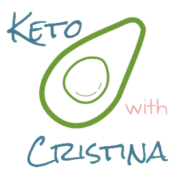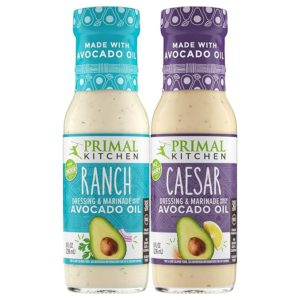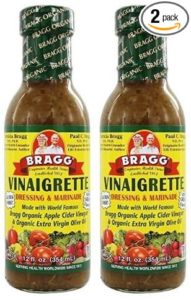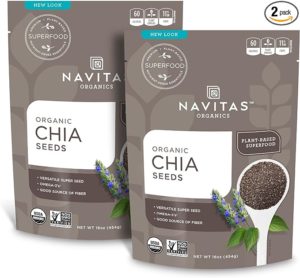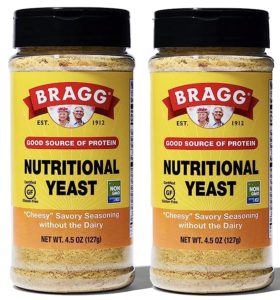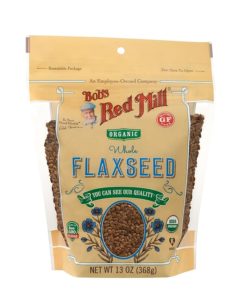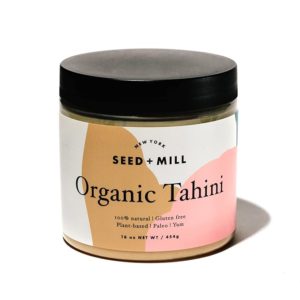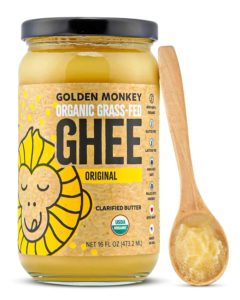This post contains affiliate links. That means that if you buy something through these links, I may earn a commission at no additional cost to you.
Are you a fan of the ketogenic diet and intermittent fasting but looking to add a refreshing twist to your meals? Look no further than delicious keto salads. While salads may not be the first thing that comes to mind when you think of keto, they can be a delicious and nutritious addition to your low-carb, high-fat lifestyle.
In this guide, I’m going to show you how to build a healthy, satisfying, and utterly delectable keto-friendly salad. I’ll share tips on choosing the right greens, proteins, fats, and veggies to keep your carb intake in check while maximizing flavor and nutrition. Plus, I’ll help you navigate the often confusing world of salad dressings, so you can enjoy a tasty salad without jeopardizing your ketosis. I love salads because I can throw a delicious one together quickly and eat a LOT of it when I’m really hungry and not feel guilty. Plus, they’re easy to meal prep–just layer it properly in jars and refrigerate; then when you’re ready to eat, just dump in a bowl and toss!
Whether you’re new to keto or a seasoned low-carb enthusiast, these salad-building strategies will inspire you to create mouthwatering salads that align with your dietary goals. Get ready to discover a world of leafy greens, flavorful proteins, and wholesome fats, all in a bowl of keto goodness.
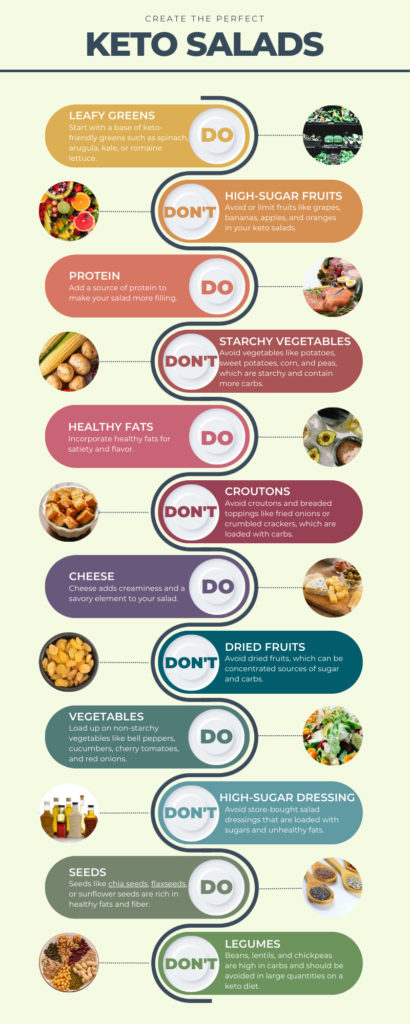
Do’s: How to Make Nutritious and Delicious Keto Salads
To create a delicious and keto-friendly salad, you can incorporate various ingredients that are low in carbs and rich in healthy fats and protein. Here are ten of the best ingredients can help you create a well-balanced and satisfying keto salad that is both nutritious and delicious:
- Leafy Greens: Start with a base of keto-friendly greens such as spinach, arugula, kale, or romaine lettuce. These greens are low in carbs and high in nutrients.
- Protein: Add a source of protein to make your salad more filling. Options include grilled chicken, sliced steak, salmon, shrimp, or hard-boiled eggs.
- Healthy Fats: Incorporate healthy fats for satiety and flavor. Avocado slices, olives, and nuts like almonds, walnuts, or pecans are excellent choices.
- Cheese: Cheese adds creaminess and a savory element to your salad. Consider feta, blue cheese, cheddar, or goat cheese in moderation.
- Low-Carb Vegetables: Load up on non-starchy vegetables like bell peppers, cucumbers, cherry tomatoes, and red onions. These veggies add crunch and color.
- Berries: While fruits are typically higher in carbs, you can add a few berries like raspberries or blackberries for a touch of sweetness and antioxidants.
- Seeds: Seeds like chia seeds, flaxseeds, or sunflower seeds are rich in healthy fats and fiber. They provide a nice crunch to your salad.
- Dressing: Use keto-friendly dressings made with olive oil, avocado oil, or MCT oil. You can also make your own dressing using these oils, vinegar, and herbs.
- Fresh Herbs: Fresh herbs like basil, cilantro, or mint can elevate the flavor of your salad without adding many carbs.
- Crispy Bacon: Crumbled bacon bits add a smoky and savory flavor while providing additional fat and protein.
Don’ts: What to Avoid When Making Keto Salads
To create an effective keto salad, it’s important to avoid ingredients that are high in carbohydrates, as the ketogenic diet primarily focuses on keeping carb intake low. Here are some salad ingredients to steer clear of or use sparingly:
- High-Sugar Fruits: While fruits are generally healthy, many are high in natural sugars. Avoid or limit fruits like grapes, bananas, apples, and oranges in your keto salads. Opt for lower-carb options like berries (in moderation) or avocados.
- Starchy Vegetables: Vegetables like potatoes, sweet potatoes, corn, and peas are starchy and contain more carbs. Minimize or exclude these from your keto salad. Instead, choose non-starchy options like leafy greens, cucumbers, and bell peppers.
- Croutons and Breaded Toppings: Croutons and breaded toppings like fried onions or crumbled crackers are loaded with carbs. Replace them with keto-friendly options like chopped nuts or seeds for crunch.
- Dried Fruits: Dried fruits can be concentrated sources of sugar and carbs. Avoid raisins, dried cranberries, and dates in your salad.
- High-Sugar Salad Dressings: Many store-bought salad dressings are loaded with sugars and unhealthy fats. Check labels carefully and opt for dressings that are low in carbs and made with healthy fats like olive oil or avocado oil.
- Sweetened Yogurt or Dressings: Some people add yogurt or dressings with added sugars to their salads. Choose plain, full-fat Greek yogurt or make your own keto-friendly dressing with simple ingredients like olive oil, vinegar, and herbs.
- Legumes: Beans, lentils, and chickpeas are high in carbs and should be avoided in large quantities on a keto diet. If you want to add legumes, use them sparingly.
- High-Carb Nuts and Seeds: While nuts and seeds are nutritious, some are higher in carbs than others. Avoid cashews and chestnuts, and opt for lower-carb options like almonds, walnuts, and chia seeds.
- High-Sugar Condiments: Be cautious of condiments like ketchup, barbecue sauce, and teriyaki sauce, as they often contain added sugars. Use low-carb condiments like mustard, mayonnaise, or hot sauce instead, or buy barbecue or teriyaki sauce with no added sugars.
- Candied or Sugared Nuts: Some pre-packaged nuts have sweet coatings that can significantly increase their carb content. Stick to plain, roasted nuts.
Track Your Macros
Remember that portion control is also important. Even keto-friendly ingredients can add up in terms of carbs if you overindulge. Pay attention to the serving sizes and track your carb intake to stay within your daily limits while enjoying a satisfying and ketogenic salad.
The Break-Down: Making Good Choices for Keto Salads
The basic building blocks to any delicious salad include greens, vegetables, protein, and dressing. There are also many options for toppings to add flavor or nutrition, and if you’re aiming for a salad to be a complete keto-friendly meal, you should of course add some healthy fats. Here, I’ll break down the basic salad building blocks and give you ideas for what to include in a delicious, nutritious keto salad, and what to avoid. Hopefully this can help you create amazing keto salads with ingredients you already have at home without having to sacrifice flavor for nutrition (or vice versa)!
Greens
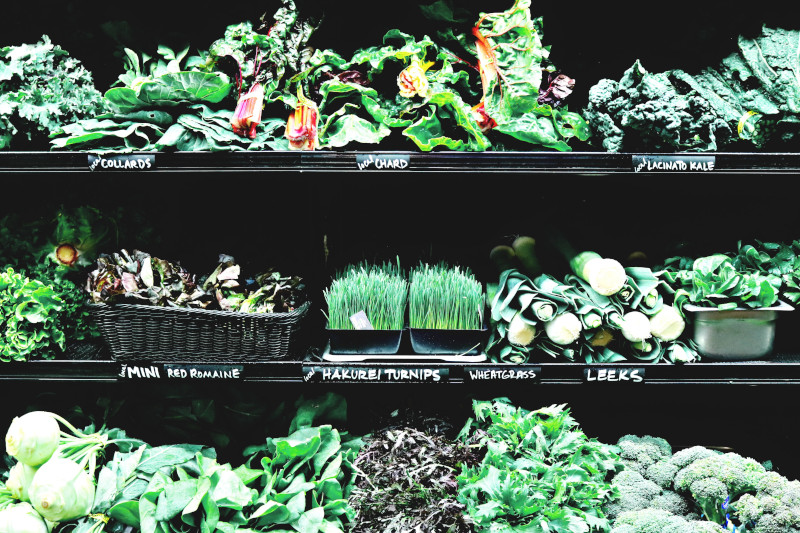
Do Choose:
When selecting greens for a keto-friendly salad, it’s important to consider their carb content and nutritional value. Here are the top ten keto-friendly greens, ranked based on their low carb content and nutritional benefits:
- Spinach: Spinach is extremely low in carbs, with less than 1 gram of net carbs per cup. It’s rich in vitamins, minerals, and antioxidants, including iron, vitamin K, and folate, which makes it a versatile, nutrient-dense base for your salad.
- Arugula: Arugula is also very low in carbs, with less than 1 gram of net carbs per cup. It has a peppery flavor that adds a unique taste to your salad, and it’s high in vitamins A and K, as well as folate and calcium.
- Romaine Lettuce: Romaine lettuce is relatively low in carbs, with about 1-2 grams of net carbs per cup. Romaine provides a satisfying crunch and is a good source of vitamin K, vitamin A, and folate. It’s a classic choice for Caesar salads.
- Kale: Kale contains about 2-3 grams of net carbs per cup. It’s a nutritional powerhouse, packed with vitamins A, C, and K, as well as fiber and antioxidants. It also adds a hearty texture to your salad.
- Swiss Chard: Swiss chard has approximately 1-2 grams of net carbs per cup. It’s s a vibrant green with a slightly earthy taste and rich in vitamins A and K, as well as magnesium and potassium.
- Iceberg Lettuce: Iceberg lettuce is relatively low in carbs, with about 1-2 grams of net carbs per cup. While lower in overall nutrients compared to some other greens, iceberg lettuce has a refreshing crispness and mild flavor. It’s a good choice for those who prefer a lighter, less bitter salad base.
- Cabbage (Green or Red): Cabbage contains approximately 2-3 grams of net carbs per cup. It’s budget-friendly, has a mild flavor, and offers a satisfying crunch. It’s a source of vitamins C and K and works well in coleslaw-style salads.
- Endive: Endive is very low in carbs, with less than 1 gram of net carbs per cup. It has a slightly bitter taste and a unique shape, making it an interesting addition to salads. It’s a good source of vitamins A and K.
- Collard Greens: Collard greens have about 1-2 grams of net carbs per cup. They are sturdy, with a slightly bitter taste. They are rich in vitamins A, C, and K, as well as calcium and fiber. Collard greens work well when sautéed or used as wraps.
- Spring Mix (Mesclun): Spring mix typically contains around 1-2 grams of net carbs per cup. It combines various baby greens like baby spinach, arugula, and chard, though it may contain some higher-carb options like red leaf lettuce or mizuna. Check the mix’s composition and use it in moderation. It offers a mix of flavors and textures, making it a versatile choice for salads.
These greens are excellent choices for keto-friendly salads because they are not only low in carbs but also packed with essential nutrients, fiber, and antioxidants. You can mix and match these greens to create a diverse and nutritious salad base while keeping your carb intake in check.
Don’t Use:
While most salad greens are relatively low in carbohydrates and can be included in a keto diet, there are a few greens you may want to use in moderation or avoid if you’re looking to keep your carb intake very low. Here are some salad greens to be cautious of on a keto diet:
- Iceberg Lettuce: Iceberg lettuce is very low in carbs, but it has limited nutritional value compared to other greens. It’s a neutral, watery base, so you may want to mix it with more nutrient-dense options.
- Bibb Lettuce: Bibb lettuce, also known as butter lettuce, is slightly higher in carbs than some other greens but can still be included in moderation.
- Radicchio: Radicchio has a bitter flavor and more carbs than some other greens. Use it in small quantities to add a touch of bitterness to your salad.
- Frisee: Frisee is slightly higher in carbs and has a bitter taste. It’s another green to use in moderation.
It’s important to note that even these greens can be part of a keto-friendly diet when used in appropriate portions. The key is to be mindful of your overall carb intake and balance these greens with lower-carb options like spinach, kale, arugula, and romaine lettuce. Mixing various greens can add flavor, texture, and nutritional diversity to your keto salads while keeping carb levels in check.
Vegetables
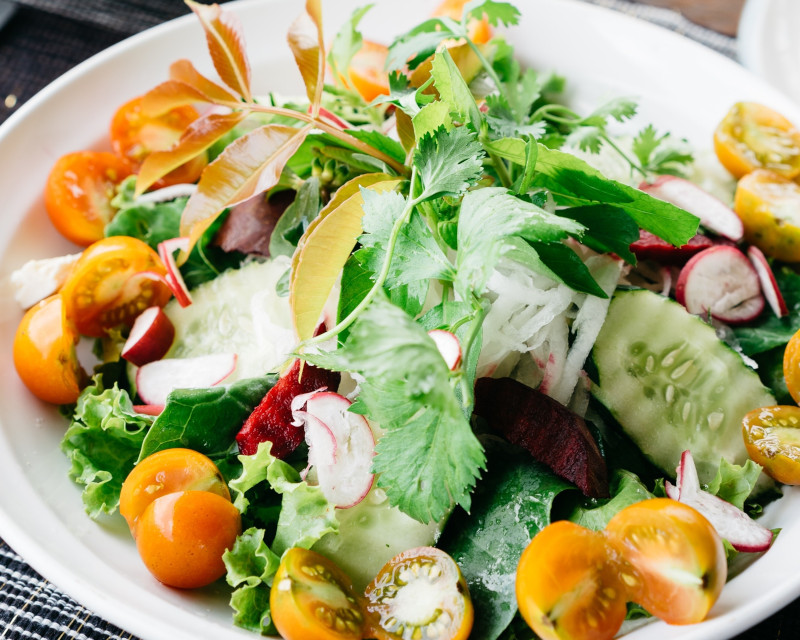
Do Choose:
Here are ten keto-friendly vegetables that can enhance the flavor and nutrition of your salad, ranked based on their nutritional value and flavor contribution:
- Bell Peppers: Bell peppers are colorful and sweet, adding a burst of flavor and vitamin C to your salad.
- Cucumbers: Cucumbers provide a refreshing crunch and a mild, hydrating flavor. They are low in carbs and high in water content.
- Cherry Tomatoes: Cherry tomatoes add a burst of sweetness and a pop of color to your salad. They’re low in carbs and rich in vitamin C and antioxidants.
- Broccoli: Broccoli florets offer a satisfying crunch and are packed with fiber, vitamins C and K, and folate. They provide a nice contrast in texture.
- Mushrooms: Mushrooms provide an earthy, umami flavor to your salad. They’re low in carbs and add depth to the overall taste.
- Zucchini or Summer Squash: These vegetables can be sliced or spiralized to add a mild, slightly sweet flavor and a pleasant texture. They’re low in carbs and rich in vitamins.
- Red Onion: Red onions offer a mild, tangy bite to your salad. They’re a source of antioxidants and add a touch of color.
- Asparagus: Asparagus spears are tender and add a slightly nutty flavor. They are low in carbs and rich in folate and vitamins A and K.
- Avocado: Avocado provides creamy richness and healthy fats to your salad. It’s also a source of potassium and fiber, enhancing both flavor and nutrition.
- Cauliflower: Cauliflower florets, when roasted or raw, offer a neutral taste and a satisfying crunch. They’re low in carbs and provide fiber and vitamins.
These vegetables can not only make your keto-friendly salad more flavorful but also boost its nutritional value. You can mix and match them to create a diverse and colorful salad that satisfies your taste buds while aligning with your ketogenic diet goals.
Don’t Use:
While most vegetables can be included in keto salads in moderation, there are some that are relatively higher in carbohydrates and should be consumed in smaller quantities or avoided if you’re strictly following a very low-carb ketogenic diet. Here are 10 vegetables to use sparingly or avoid in keto salads, along with reasons:
- Potatoes: Potatoes are very high in carbs, primarily starch, making them unsuitable for a keto diet. They can quickly exceed your daily carb allowance.
- Sweet Potatoes: Sweet potatoes are also high in carbs, particularly natural sugars. Consuming them in large quantities can hinder ketosis.
- Corn: Corn is starchy and contains a significant amount of carbohydrates. It’s best to limit or omit corn in keto salads.
- Peas: Peas are relatively high in carbs compared to other vegetables. A small portion can add up quickly in terms of net carbs.
- Carrots: Carrots have a sweeter flavor due to their natural sugar content. While they can be included in small amounts, they should be used sparingly.
- Beets: Beets are root vegetables with a relatively higher carb content. Their natural sugars can affect ketosis if consumed in large quantities.
- Butternut Squash: Butternut squash is starchy and contains more carbs than many other vegetables. It’s best to limit its use in keto salads.
- Acorn Squash: Acorn squash, like butternut squash, is starchy and relatively high in carbs. It’s not a keto-friendly choice in large portions.
- Parsnips: Parsnips have a sweet, earthy flavor and a higher carb content compared to keto-friendly vegetables. Use them sparingly.
- Turnips: While turnips have fewer carbs than some other root vegetables, they are still relatively higher in carbs compared to many leafy greens and other keto-friendly options.
While these vegetables can certainly be part of a balanced diet, they should be enjoyed in smaller quantities or less frequently if you’re aiming to maintain a strict ketogenic state. Instead, focus on low-carb, leafy greens and non-starchy vegetables to create satisfying and keto-friendly salads.
Protein
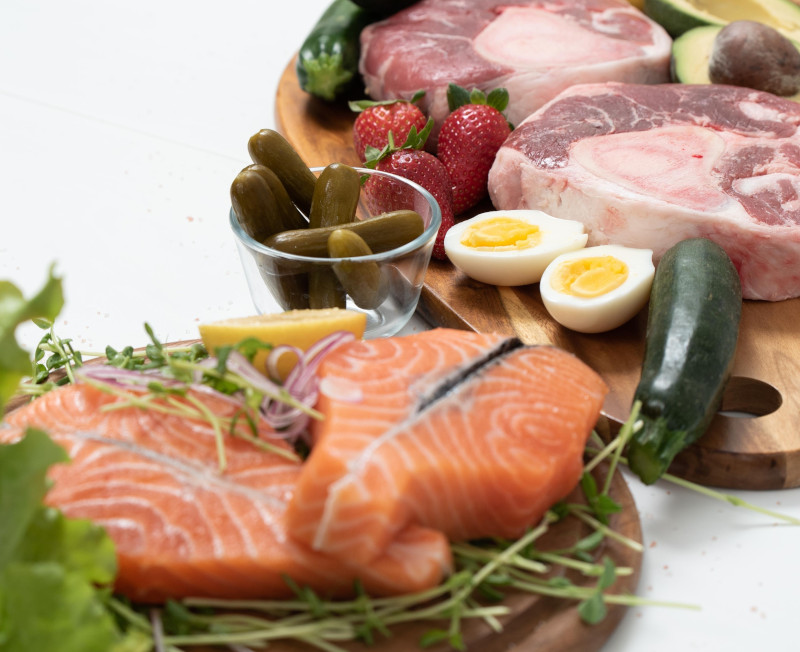
Do Choose:
Adding keto-friendly protein to your salad can make it more satisfying and help you meet your daily protein intake. Here are some quick and easy ways to incorporate protein into your keto salad:
- Grilled Chicken: Pre-cooked or grilled chicken breast or thigh slices are a classic choice. Season with herbs and spices for extra flavor.
- Hard-Boiled Eggs: Slice or chop hard(or soft)-boiled eggs and sprinkle them over your salad. They’re quick to prepare and rich in protein.
- Canned Tuna or Salmon: Canned tuna or salmon in water or olive oil is a convenient and protein-rich option. Simply drain and flake it over your salad.
- Shrimp: Pre-cooked shrimp is readily available in many grocery stores. Toss them on your salad for a seafood twist.
- Tofu: If you prefer plant-based protein, cubed and pan-fried tofu can be added to your salad. It’s versatile and takes on the flavors of your dressing and seasonings.
- Bacon: Crumbled bacon bits add both protein and a savory, smoky flavor. Use them sparingly for added crunch.
- Beef or Pork Strips: Leftover grilled or roasted beef or pork can be thinly sliced and placed on your salad. Ensure it’s cooked to your preferred level of doneness.
- Cottage Cheese: Full-fat cottage cheese can be a creamy and protein-packed addition. Spoon it onto your salad.
- Seeds: Seeds like sunflower seeds and pumpkin seeds are protein-rich and can be sprinkled on your salad for added crunch.
- Cheese: Grated or cubed cheese varieties like cheddar, mozzarella, or feta not only provide protein but also add a creamy texture and savory taste.
- Salami or Pepperoni: Thinly sliced salami or pepperoni can be a flavorful, protein-rich topping for your salad.
- Leftover Steak or Chicken: If you have leftover cooked steak or chicken from a previous meal, slice it thinly and use it to top your salad for a quick and convenient protein source.
Remember to monitor portion sizes and choose lean cuts of meat or plant-based proteins if you’re concerned about your overall fat intake. Pair your protein with keto-friendly vegetables and fats to create a well-balanced, satisfying keto salad.
Don’t Use:
To keep a salad keto-friendly, you should be cautious with certain common salad protein sources that may contain added sugars or breading, which can significantly increase the carb content. Here are some protein sources to be mindful of and potentially avoid:
- Breaded Proteins: Avoid breaded items like chicken tenders, fried shrimp, or breaded tofu. The breading typically contains flour and breadcrumbs, which are high in carbs.
- Croutons: Croutons are pieces of bread that are typically fried or baked and then added to salads. They are high in carbs and should be avoided on a keto diet.
- Sweetened Bacon: Some pre-packaged bacon varieties have added sugar in the curing process. Check the label for sugar content and choose sugar-free bacon options.
- Marinated Meats: Some pre-marinated meats or proteins may contain sugary marinades or glazes. Opt for plain, unseasoned options, and add your own keto-friendly seasonings.
- Fruits: While fruits like dried cranberries or candied nuts are common salad toppings, they can be high in sugar and carbs. Choose lower-carb alternatives like fresh berries or nuts without added sugars.
- Honey Mustard or Sweet Dressings: Salad dressings like honey mustard or sweet vinaigrettes can contain added sugars. Check the label for sugar content and opt for dressings with no added sugars.
- Canned Proteins in Sauces: Canned proteins like tuna or chicken often come in sauces that may contain added sugars or high-carb ingredients. Choose products packed in water or oil without added sugars.
- Barbecue Sauce: Be cautious with barbecue sauce on grilled proteins like chicken or steak, as many barbecue sauces are loaded with sugar. Opt for sugar-free or keto-friendly barbecue sauce options if available.
- Pre-made Salad Proteins: Some pre-made or pre-seasoned salad proteins from delis or salad bars may contain high-carb sauces or glazes. Check ingredients and choose plain proteins when possible.
- Honey-Glazed or Teriyaki Proteins: Proteins with honey glazes or teriyaki sauces are often high in sugar and carbs. Choose unglazed or sugar-free versions.
To maintain ketosis and keep your salad keto-friendly, prioritize plain, unprocessed proteins or those with minimal added ingredients. Check nutrition labels and ingredient lists to ensure your protein choices align with your ketogenic goals. Opt for grilled, roasted, or pan-seared proteins seasoned with keto-friendly herbs and spices to enhance the flavor of your salad without adding unnecessary carbs.
Fats
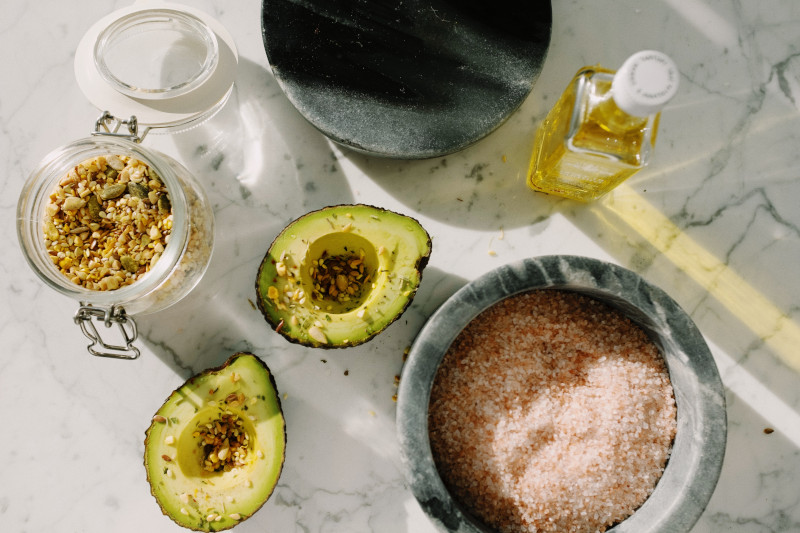
Do Choose:
Adding healthy fats to your salad is a great way to make it keto-friendly while enhancing both flavor and satiety. Here are some delicious and keto-approved fats you can easily incorporate into your salads:
- Avocado: Avocado is a fantastic source of healthy fats and adds creaminess to your salad. Slice it or mash it to create a creamy dressing.
- Olive Oil: Extra virgin olive oil is a staple in Mediterranean cuisine and provides monounsaturated fats. Drizzle it as a salad dressing or use it to sauté vegetables and proteins.
- Nuts: Various nuts like almonds, walnuts, and macadamia nuts are rich in healthy fats and offer a satisfying crunch. Chop them and sprinkle them on top.
- Seeds: Seeds such as chia seeds, flaxseeds, and pumpkin seeds are excellent sources of healthy fats and fiber. They add texture and nutritional value to your salad.
- Cheese: Cheese, especially varieties like feta, blue cheese, and goat cheese, can be a creamy, savory addition that provides healthy fats. Use it in moderation.
- Fatty Fish: Adding fatty fish like salmon, mackerel, or sardines to your salad not only increases healthy fat content but also boosts protein intake.
- MCT Oil: Medium-chain triglyceride (MCT) oil is a popular supplement for ketogenic diets. It’s flavorless and can be drizzled over your salad for an extra dose of healthy fats.
- Coconut: Shredded coconut or coconut flakes can be toasted and sprinkled on your salad for a tropical twist and a dose of healthy coconut fats.
- Bacon: While not considered a “health food” in the traditional sense, bacon is a keto-friendly fat source. Crumble or chop crispy bacon to add a smoky, savory element. Just make sure there aren’t any added sugars during the curing process.
- Sour Cream or Greek Yogurt: These dairy products provide healthy fats and creaminess. Opt for full-fat versions and use them sparingly as a dressing or topping.
- Tahini: This sesame seed paste is rich in healthy fats and adds a nutty, savory flavor. Blend it with lemon juice and garlic for a tasty tahini dressing.
- Butter or Ghee: Use a small amount of butter or ghee to sauté vegetables or proteins before adding them to your salad for added richness.
Remember to balance your fats with other nutrients, such as proteins and low-carb vegetables, to create a well-rounded and satisfying keto-friendly salad.
Don’t Use:
To keep your salad keto-friendly, it’s important to avoid certain fats that can be high in unhealthy saturated or trans fats, as well as those that may contain added sugars or unhealthy additives. Here are some fats to be cautious of when adding fats to your salad:
- Hydrogenated or Partially Hydrogenated Oils: These oils contain trans fats, which are associated with health risks. Avoid dressings or toppings made with these oils.
- Vegetable Oils: Highly processed vegetable oils like soybean oil, corn oil, and canola oil are often used in commercial salad dressings. They are high in omega-6 fatty acids and may promote inflammation when consumed in excess.
- Margarine: Margarine often contains trans fats and should be avoided in favor of healthier fat sources like butter or olive oil.
- Store-Bought Dressings with Added Sugars: Many pre-packaged salad dressings contain added sugars to enhance flavor. Check the label for sugar content and choose dressings with little to no added sugars.
- Low-Quality Mayonnaise: Some low-quality mayonnaise brands use unhealthy oils and additives. Look for mayo made with avocado oil or olive oil or make your own keto-friendly mayo.
- Processed Bacon Bits: Pre-packaged bacon bits may contain unhealthy fats and artificial additives. Choose real, crispy bacon and crumble it yourself.
- Candied Nuts: Nuts with sugary coatings can significantly increase the carb content of your salad. Opt for plain, roasted nuts without added sugars.
- High-Sugar Condiments: Certain condiments like ketchup, barbecue sauce, and teriyaki sauce can be high in added sugars. Use low-carb alternatives or make your own keto-friendly versions.
- Creamy Dressings with Low-Quality Ingredients: Creamy dressings made with unhealthy oils and additives should be avoided. Opt for dressings made with high-quality ingredients like avocado oil or full-fat dairy products.
- Sweetened Yogurt: Some people use sweetened yogurt as a creamy dressing base. Choose plain, full-fat Greek yogurt or sour cream instead and sweeten it with keto-friendly sweeteners if desired.
When adding fats to your keto salad, focus on using high-quality sources like olive oil, avocado oil, nuts, seeds, and healthy dairy products. Reading ingredient labels and being mindful of the types of fats used in store-bought dressings and toppings is essential to maintain a keto-friendly salad that supports your health and dietary goals.
Dressing
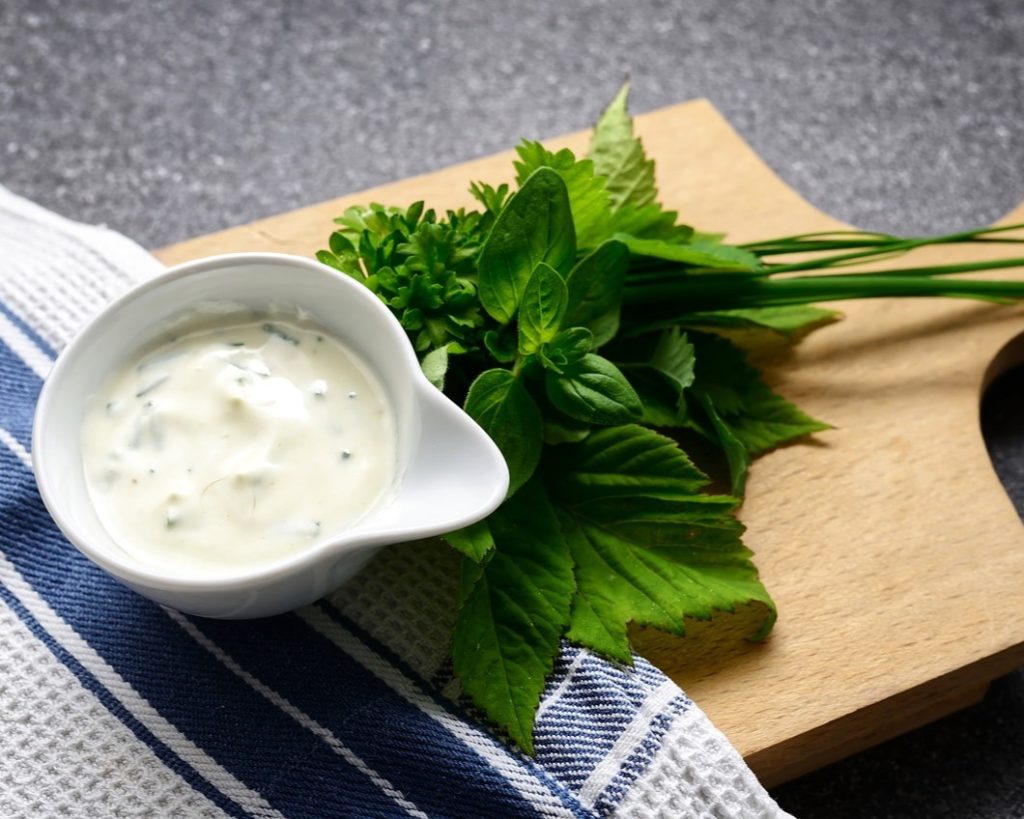
Do Choose:
To ensure a salad dressing is keto-friendly, there are several key factors to check on the label. Here’s a checklist for selecting keto-friendly salad dressings:
- Net Carbohydrates: Look for dressings with minimal net carbs, often around 2 grams or fewer per serving. Net carbs are calculated by subtracting dietary fiber and sugar alcohols from total carbohydrates.
- Sugar Content: Ensure that the dressing is either sugar-free or contains minimal added sugars. Ideally, it should have 1 gram of sugar or less per serving (not including sugar alcohols, which are not digested and don’t affect blood sugar).
- Healthy Fats: Seek dressings made with healthy fats like avocado oil or olive oil, as these fats align with a ketogenic diet and provide essential nutrients.
Here are some great store-bought dressing choices:
- Primal Kitchen Ranch Dressing: This dressing is keto-friendly because it contains only 2 grams of net carbs per serving, no added sugars, and is made with avocado oil, a healthy source of fat that fits well within the keto macronutrient profile.
- Ken’s Steak House Buttermilk Ranch Dressing: It’s a keto-friendly option with around 3 grams of net carbs per serving, minimal added sugars, and is a creamy choice that can enhance the flavor of your salad while keeping carbs in check.
- Newman’s Own Olive Oil & Vinegar Dressing: This dressing is keto-friendly due to its low carbohydrate content (around 1 gram of net carbs per serving), no added sugars, and the use of olive oil, a heart-healthy fat.
- Bragg Organic Vinaigrette Dressing: It’s a keto-friendly choice with 2 grams of net carbs per serving, no added sugars, and the vinegar-based nature of vinaigrette dressings typically results in lower carbohydrate content.
- Primal Kitchen Caesar Dressing: This keto-friendly option has 2 grams of net carbs per serving, no added sugars, and is made with avocado oil, ensuring a favorable fat profile for those following a ketogenic diet.
By checking for low net carbs, minimal sugar, and healthy fats in these salad dressings, you can confidently select options that align with the ketogenic diet’s principles and keep your carb intake within the desired range while enjoying flavorful salads.
Now for some quick and easy, perfectly keto-friendly homemade dressings:
1. Classic Olive Oil and Balsamic Vinaigrette:
Ingredients:
- 1/4 cup extra virgin olive oil
- 2 tablespoons balsamic vinegar
- 1 clove garlic, minced (optional)
- 1/2 teaspoon Dijon mustard
- Salt and pepper to taste
Directions:
- In a bowl, whisk together the olive oil, balsamic vinegar, minced garlic (if using), Dijon mustard, salt, and pepper.
- Taste and adjust the seasonings if needed.
- Drizzle over your salad and toss before serving.
Nutritional Info (per serving, makes 4 servings):
- Calories: 130
- Fat: 14g
- Net Carbs: 1g
- Protein: 0g
2. Creamy Avocado Lime Dressing:
Ingredients:
- 1 ripe avocado
- Juice of 1 lime
- 1/4 cup sour cream or Greek yogurt
- 2 tablespoons extra virgin olive oil
- 1 clove garlic, minced
- Salt and pepper to taste
- Water (to thin, if needed)
Directions:
- In a blender or food processor, combine the avocado, lime juice, sour cream or Greek yogurt, olive oil, minced garlic, salt, and pepper.
- Blend until smooth. If the dressing is too thick, add a little water to reach your desired consistency.
- Use immediately or refrigerate for later use.
Nutritional Info (per serving, makes 4 servings):
- Calories: 124
- Fat: 12g
- Net Carbs: 2g
- Protein: 1g
3. Lemon Tahini Dressing:
Ingredients:
- 1/4 cup tahini
- Juice of 1 lemon
- 2 tablespoons extra virgin olive oil
- 1 clove garlic, minced
- 2 tablespoons water (or more for desired consistency)
- Salt and pepper to taste
Directions:
- In a bowl, whisk together the tahini, lemon juice, olive oil, minced garlic, water, salt, and pepper until smooth.
- Add more water if necessary to reach your preferred thickness.
- Drizzle over your salad and enjoy.
Nutritional Info (per serving, makes 4 servings):
- Calories: 117
- Fat: 11g
- Net Carbs: 2g
- Protein: 2g
4. Ranch-Style Keto Dressing:
Ingredients:
- 1/2 cup mayonnaise
- 1/2 cup sour cream
- 1/4 cup heavy cream
- 1 teaspoon dried dill
- 1 teaspoon dried parsley
- 1/2 teaspoon garlic powder
- 1/2 teaspoon onion powder
- Salt and pepper to taste
Directions:
- In a bowl, whisk together the mayonnaise, sour cream, heavy cream, dried dill, dried parsley, garlic powder, onion powder, salt, and pepper.
- Taste and adjust seasonings as needed.
- Store in the refrigerator and shake or stir before using.
Nutritional Info (per serving, makes 8 servings):
- Calories: 163
- Fat: 18g
- Net Carbs: 1g
- Protein: 1g
5. Cilantro Lime Dressing:
Ingredients:
- Juice of 2 limes
- 1/4 cup extra virgin olive oil
- 2 tablespoons fresh cilantro, chopped
- 1 clove garlic, minced
- Salt and pepper to taste
Directions:
- In a bowl, whisk together the lime juice, extra virgin olive oil, chopped cilantro, minced garlic, salt, and pepper.
- Drizzle over your salad and enjoy the zesty flavors.
Nutritional Info (per serving, makes 4 servings):
- Calories: 108
- Fat: 12g
- Net Carbs: 1g
- Protein: 0g
Feel free to adjust these recipes to your taste preferences and salad choices. Homemade dressings are a great way to control the ingredients and flavors while keeping your salads keto-friendly.
Don’t Use:
When selecting salad dressings for a healthy keto-friendly salad, it’s essential to avoid options that contain added sugars, high-carb ingredients, and unhealthy fats. Here are some salad dressings to be cautious of and potentially avoid:
- Honey Mustard Dressing: Honey mustard dressings typically contain both honey and sugar, which contribute to high carb content.
- Sweet Vinaigrettes: Salad dressings with sweet flavors like raspberry vinaigrette or balsamic glaze often have added sugars.
- Thousand Island Dressing: Many commercial Thousand Island dressings contain high-fructose corn syrup and added sugars.
- Asian-Style Dressings: Some Asian-style dressings, such as sesame ginger or teriyaki, can be high in sugar and carbs.
- Low-Fat Dressings: Low-fat dressings often compensate for reduced fat content by adding extra sugar or thickeners. Opt for full-fat dressings with healthy fats instead.
- Blue Cheese Dressing: While blue cheese dressing can be keto-friendly in moderation, some store-bought varieties have added sugars. Check the label for sugar content and choose brands with fewer carbs.
- Balsamic Reductions: Balsamic reductions are often concentrated and can contain significant sugar content. Use them sparingly or opt for plain balsamic vinegar.
- French Dressing: Many French dressings contain added sugars and should be avoided.
- Store-Bought Caesar Dressing: Some Caesar dressings may contain added sugars or unhealthy fats. Check the label for ingredients and opt for keto-friendly or homemade versions.
- Low-Quality Ranch Dressings: Some ranch dressings made with low-quality oils and additives may not be keto-friendly. Choose ranch dressings made with healthy oils like avocado oil or olive oil.
It’s crucial to read nutrition labels carefully when selecting salad dressings, paying attention to total carbohydrates and added sugars. Whenever possible, choose dressings made with high-quality ingredients and healthy fats like avocado oil or olive oil. Try to opt for versions with no added sugars or make your own with keto-friendly sweeteners. Making your own keto-friendly dressings at home allows you to have full control over the ingredients and flavor while ensuring they align with your dietary goals.
Additional Toppings
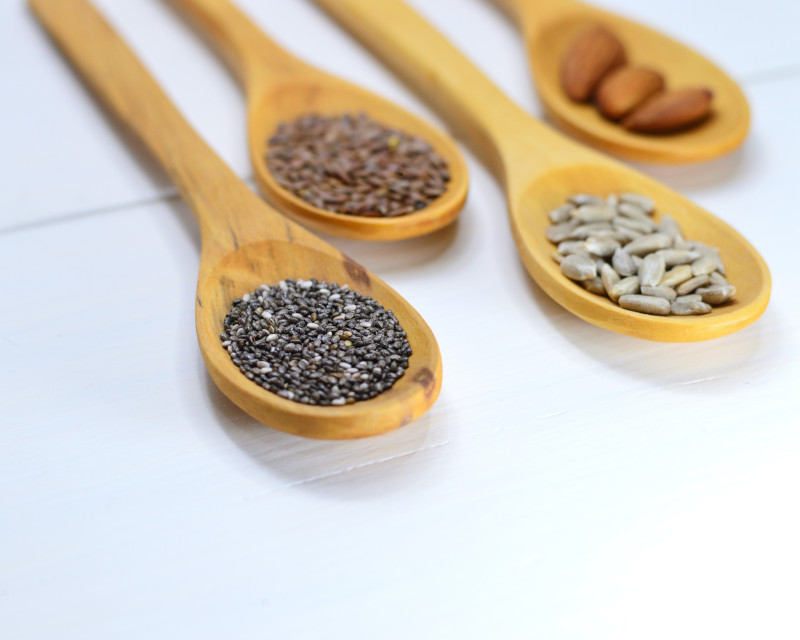
Do Choose:
Here are 10 additional low-carb toppings that can add flavor, texture, and nutrition to your salad without significantly increasing carb content:
- Chia Seeds: Chia seeds are rich in fiber, healthy fats, and antioxidants. They can provide a subtle crunch and enhance the nutritional value of your salad.
- Hemp Hearts: Hemp hearts are a great source of plant-based protein, omega-3 fatty acids, and vitamins. They add a nutty flavor and a boost of nutrition.
- Pumpkin and Sunflower Seeds: Pumpkin and sunflower seeds are high in healthy fats, protein, vitamin E (sunflower) and minerals like magnesium (pumpkin). They offer a satisfying crunch to your salad.
- Nutritional Yeast: Add nutritional yeast to a salad to enhance its flavor and provide a boost of nutrients, including B vitamins, protein, and minerals. Nutritional yeast has a cheesy, nutty flavor that can mimic the taste of grated cheese in salads, making it a popular choice for both flavor and nutrition.
- Sesame Seeds: Toasted sesame seeds can impart a rich, nutty taste to your salad. They are a good source of healthy fats, protein, and minerals.
- Basil Leaves: Fresh basil leaves can infuse your salad with aromatic, herbaceous flavor. They’re low in carbs and calories.
- Cilantro Leaves: Cilantro adds a fresh and zesty flavor to salads. It’s a low-carb herb that pairs well with various cuisines.
- Green Onions (Scallions): Green onions provide a mild onion flavor without an excessive carb load. They also add a pop of color.
- Radishes: Sliced radishes offer a crisp texture and a peppery kick to your salad. They’re low in carbs and calories.
- Pickles (Dill or Gherkins): Pickles can provide a tangy, sour note to your salad. Look for pickles without added sugars to keep it keto-friendly.
These toppings are excellent choices for enhancing the flavor, nutrition, and variety of your keto-friendly salads. They’re low in carbs and can be combined creatively to suit your taste preferences and dietary goals.
Don’t Use:
When following a keto lifestyle, it’s important to be mindful of salad toppings that can be high in carbs and may hinder ketosis. Here are 10 common salad toppings to avoid on a keto diet:
- Croutons: Croutons are typically made from bread and are high in carbohydrates, making them unsuitable for keto.
- Dried Fruits: Raisins, cranberries, and other dried fruits are concentrated sources of sugar and carbs, so they should be avoided.
- Candied Nuts: Nuts coated in sugary glazes or candied coatings can add a significant amount of carbs to your salad.
- Honey-Roasted Nuts: Honey-roasted nuts contain added sugars, which are not keto-friendly.
- Sweetened Yogurt or Dressings: Salad dressings and yogurt-based toppings with added sugars can contribute to high carb intake.
- Balsamic Reductions: Balsamic reductions are often made by simmering down balsamic vinegar to concentrate its sugars, so they are high in carbs.
- Crunchy Chow Mein Noodles: These noodles are fried and coated in sugar, making them high in both carbs and unhealthy fats.
- Caramelized Onions: Onions that have been caramelized may contain added sugars, increasing their carb content.
- Crispy Wonton Strips: Like chow mein noodles, crispy wonton strips are fried and high in carbs.
- Taco Chips or Tortilla Strips: Taco chips or tortilla strips are made from corn or flour and are not keto-friendly due to their high carb content.
To maintain ketosis, opt for low-carb alternatives and be sure to check ingredient labels to avoid added sugars or high-carb ingredients when selecting salad toppings. This way, you can enjoy a satisfying and keto-friendly salad that supports your dietary goals.
The Skinny
Incorporating keto-friendly salads into your meal plan doesn’t have to be boring or bland. With the right ingredients and creativity, you can turn a simple salad into a gourmet experience that supports your ketogenic journey. Try some of my favorites here:
Remember, the key to a successful keto salad is balance. Start with a foundation of low-carb greens like spinach or arugula, add a generous serving of healthy fats like avocado and nuts, top it with your favorite protein source, and drizzle on a keto-friendly dressing. Experiment with flavors, textures, and ingredients to keep your salads exciting and satisfying.
Whether you’re enjoying a crisp Caesar salad, a zesty Mediterranean bowl, or a savory steakhouse creation, your keto-friendly salads can be as diverse and delicious as your cravings allow. So, grab your salad bowl and embark on a culinary adventure that fuels your body, pleases your taste buds, and keeps you on track with your keto and intermittent fasting goals. Cheers to a healthier, happier you!
